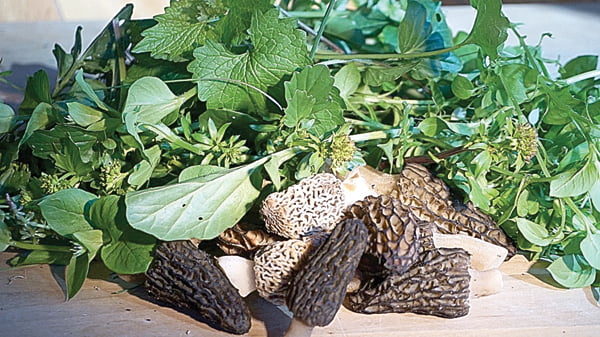
Ken Springer
Watoga Park Foundation
Foraging in the
Time of Coronavirus
I admit it. Such a shameless rip-off of Gabriel Garcia Marquez’s classic novel of endless passion, Love in the Time of Cholera.
However, foraging can get you off the couch and into the woods. This skill can be safely practiced alone or with others while maintaining a proper distance.
Author’s note: the word “foraging” has been challenged in recent years by the use of the word “wildcrafting,” when referring to the activity of procuring foods from the wild. I dare say that our pre-agricultural ancestors, were we to speak to them in their own dialect, would not say when asked how they obtain food, “Well, we hunt bison and deer, but most of our food comes from wildcrafting.”
There are a number of reasons why foraging for wild edible plants is a good idea, particularly at a time when a serious and highly contagious disease is sweeping through our country. A disease that can be prevented by eliminating or minimizing human contact.
Each and every time you enter a grocery store you are potentially exposing yourself to coronavirus – that’s a fact – as opposed to just a theory.
So, if you are running low on greens, you can go out for a nice hike and return home with a mess of creasy greens.* They are more nutritious, fresher and seriously cheaper than a bag of kale. And, more importantly, you didn’t risk your life to obtain them.
“But,” you ask, “are wild foods really more nutritious?”
Lamb’s quarters, a progenitor of cultivated spinach, is much higher in Vitamins A and B2, plus iron, phosphorus and calcium with a dash of protein thrown in as a bonus. One source states that a cup of lamb’s quarters or purslane contains more vitamins and minerals than 14 cups of domestic spinach. Both of these wild plants are found in abundance right here in Pocahontas County.
Many people today, even us golden-agers, appreciate that exercise and a reasonable diet translates to good health. What better way to have both at the same time than foraging?
It is estimated that a 175-pound individual burns about 450 calories per hour hiking on a level surface. Take a look around you folks, I think that you will agree that flat terrain is a rare commodity in these parts.
It is a safe bet that we can upgrade to a much higher calorie-burn here in Pocahontas County on just about any trail we choose, other than the Greenbrier River Trail, of course.
So, let’s say that you decide to be a good citizen and pull up the invasive garlic mustard along the Greenbrier River Trail. If you weigh in at 155 pounds you will burn nearly 250 calories per hour at a moderate walking pace. This doesn’t include the extra calories burned pulling up the garlic mustard by its roots.
And if you should decide to pull up that garlic mustard over the next week, while the plant is still tender, be sure to bring a mess home with you. This out-of-control control plant is taking over areas that were once occupied by native plant species, such as trillium and bloodroot. So, eating it may be an effective and delicious strategy to reduce its numbers.
Garlic mustard weighs in heavy on minerals, too, offering selenium, copper, manganese, iron, potassium, calcium and magnesium. It is a veritable vitamin pill when you add in the omega-fatty acids it provides.
This dispatch has only scratched the surface of wild foods growing throughout our region. But before you head out with a knife and bag to start collecting your dinner, make sure you can identify each and every plant you collect.
Among all of those leafy delectables, are some very dangerous plants – poison hemlock, water hemlock and nightshade just to name a few.
The same is true about mushrooms in our area – many are edible, delicious and nutritious, but some are deadly such as Amanita virosa and the Deadly Galerina.
Learn from an expert about foraging and get a good book on plant and mushroom identification if you want to stay safe.
And always take two bags when foraging for plants or mushrooms – one for the “knowns” that you have positively identified and another for those you are not sure of.
Be smart and be safe when foraging and you may live to a ripe old age with lots of grandchildren that you can teach to forage safely.
I was going to close by suggesting you read Love in the Time of Cholera if you have not already done so; it’s delightful.
But perhaps there is another book by Gabriel Garcia Marquez that is far more appropriate for this moment in history – One Hundred Years of Solitude.
Or so it seems!
* Creasy Greens is a regional term for winter cress.
Ken Springer
ken49bon@gmail.com


